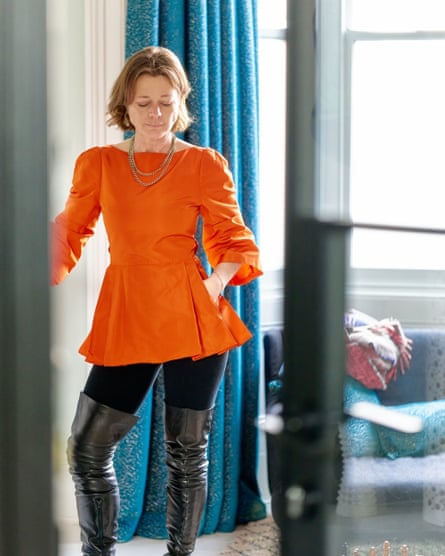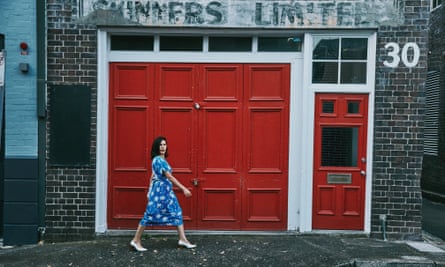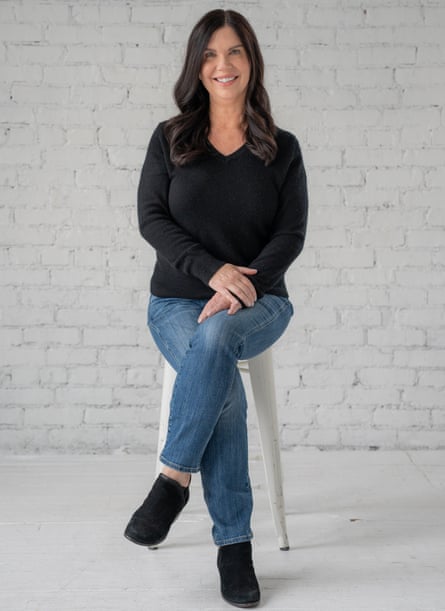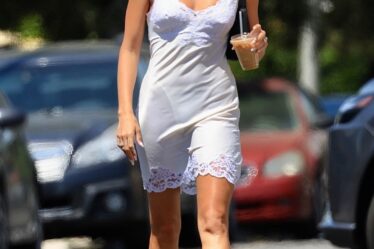
To combat global heating, people in wealthy countries need to stop buying so many clothes. Australians buy more cheap fashion than any other wealthy nation, according to the Berlin-based thinktank Hot or Cool Institute, and need to reduce their clothing consumption by 74%.
This calculation is based on the assumption fashion emits 4% of global greenhouse gas emissions (not the oft-quoted but inaccurate 10%). The institute suggests buying just five new items of clothing a year, something that prompted the British fashion editor and author Tiffanie Darke to create a wardrobe challenge called the rule of five.
Darke’s challenge permits one new purchase a season, not counting lingerie, socks and underwear. Some vintage is allowed, as are rental, repair, alterations and borrowing from friends.
Although it might be the newest online movement designed to help people contain their shopping habits, it’s not the first. Challenges including Buy Nothing New and Project 333 have already been popular for several years.
All of them come with limitations and frustrations but advocates for each say they are far outweighed by the rewards. Here adherents of each system share how the shopping pledges helped them rediscover their wardrobes and develop their own sense of style.
Rule of five
When Darke read the Hot or Cool Institute’s report she realised if she believed in helping the world achieve emissions reductions, the very least of her personal responsibilities was to buy only five new items of clothing a year. “Although five is a tough number, it’s … doable,” she says.
Last year was her first attempt. She found unexpected benefits from limiting her purchases: like the creative joy of mending, altering and styling her existing wardrobe. There was also reprieve in no longer shopping for kicks and reassurance. “Basically, I fell in love with my wardrobe again,” she says.
“The swapping party I held was a highlight” from her first year, she says. “It was so much fun and I got loads of new stuff.”
Although she describes some of the periods as dark, including a summer holiday in a different climate where all the clothes in her suitcase felt depressing, she can’t imagine going back to the way she shopped before.
She recommends anyone contemplating the challenge begins with a wardrobe audit, to highlight the one thing you really need. Once you’ve worked that out, do lots of research until you find the perfect garment. This delayed gratification makes it “super fun when you finally get this thing you love”.
Buy nothing new
The journalist Jeanette Francis, better known as Jan Fran, has not bought a new item of clothing since 2018. At the time she was hosting a nightly show and wearing a different fast fashion outfit every episode. The mounting wardrobe caused her to realise how many of her barely worn clothes were destined for landfill. She and her stylist resolved to buy nothing new for the next year. With the exception of sneakers, underwear, swimwear and workout gear, Francis has stuck to this rule ever since.
“I wish I’d known how fun and joyful it would be,” she says. “Buying secondhand frees you up to find your particular style and allows you to be really, really creative.”
after newsletter promotion

But abstaining from the convenience of new requires more than a few adjustments. It takes patience to shop secondhand. “Not all sizes are available, so you might like something, but it’s not your size so you have to take it to a tailor to get it let out or taken in,” she says.
These limitations – and the need to plan ahead – mean she’s always on the lookout for pieces that she likes. “Vinnies is my best friend. There’s one up the road from my house that I pop into every time I pass it just to see what’s going on,” she says. “I also buy a lot of stuff on Instagram from vintage and secondhand accounts that I follow.”
For anyone considering embarking on a secondhand journey, she recommends not being too hard on yourself. “Be aware that it might cost you some money. Believe it or not, if you want to wear good tailored vintage clothing, it’s not particularly cheap,” she says. “But my advice would be just start doing it, have patience and see how you go.”
Project 333
Courtney Carver created Project 333 out of a desire to simplify her life and her wardrobe. “My closet was always chaotic but I kept adding and adding,” she says. “I needed some self-imposed limits.”

The challenge she invented – and has since written a book about – is to live with a minimalist wardrobe of just 33 items for three months including garments, accessories, jewellery, footwear and outerwear. Underwear, socks, pyjamas, house clothes, workout gear and one or two sentimental pieces of jewellery don’t count.
The rest of your wardrobe has to be stored away, out of sight and mind, until the end of the three months when you can stop the challenge or reassess and rotate pieces in and out. Carver has been living with a 33-piece wardrobe for 13 years. The best thing about it is having “more peace and ease”, she says. “[Making] fewer decisions about what to wear has made an amazing difference in how I feel.”
The hardest thing is the overthinking that accompanies making your initial selection: “When we consider dressing with less, we think about everything that could go wrong. What about the weather? What about my job? What about … insert fear here?”
The first time she did Project 333, she was working in a corporate job and had to meet clients and team members and attend events – things she thought would require lots of different outfits. But she found: “No one noticed my wardrobe was much smaller.”
She realised concerns such as work and weather “aren’t a problem, but thinking about them can get in the way of getting started”. It’s worth persevering though. The challenge “gave me great freedom when making other decisions in my life. I’m not so concerned about what other people think any more”.



